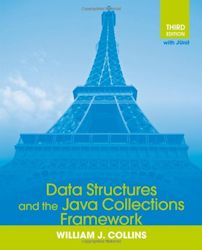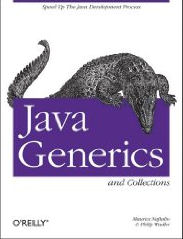| Introduction | Books |
| Gotchas | Learning More |
| Examples of Collections | Links |
| Alternatives |
You will see the term used in three contexts:
In Java version 1.5 or later the Collection classes are generified to keep track of the class of the elements permitted to be contained in them.
All classes that implement Collection automatically implement the superinterface Iterable, allowing you to iterate over all their elements.
| Collection Classes and Interfaces | ||||
|---|---|---|---|---|
| Class | Implements
or Extends Collection Interface |
Interface or Collection | Synchronised | Notes |
| AbstractCollection | abstract class | an interface to act as skeleton to build most classes that implement the Collection, interface. | ||
| java.lang.reflect.Array | class | Reflection classes used to dynamically create Array objects where you don’t know anything about them at compile time. You probably were looking for Arrays instead. | ||
| java.sql.Array | interface | A class for storing and retrieving arrays in an SQL (Standard Query Language) database. You probably were looking for Arrays instead. | ||
| ArrayList | class | A non-thread-safe List that is marginally faster than thread-safe Vector. In versions prior to Java version 1.4, the difference was more pronounced — 3 to 4 times faster. Rolling your own non-Collection array is about 4 times faster than Vector. In earlier non-optimising JVM (Java Virtual Machine) s, the difference was more like 40 times faster. The main overhead of using ArrayList and Vector is the casting needed to fish out the elements. ArrayList is like a [] array that automatically grows. Lookup by dense ints. Considerably faster than a HashMap. | ||
| Arrays | class | static methods for sorting and searching ordinary arrays, e.g. binarySearch, fill, sort. asList converts an array into a List Collection you can then feed to methods expecting a Collection or List. Don’t confuse this with the two Array classes. | ||
| Collection | interface | The interface that all collections implement that guarantee you can always
add, remove,
clear, size,
iterator, contains,
toArray etc. in a standard way. Don’t
confuse this with the Collections class.
toArray can be made smarter if you pass it an
empty array to fill just the right size. Then you have an array of specific
classes, not just generic Objects. Use it like
this:
The Collection. toString method implemented by all Collections is a great debugging tool to dump out the entire contents of a Collection in a reasonably human-readable format enclosing each element in []. | ||
| Collections | class | static methods for operating on collections, e.g. sort, binarySearch, min, max, shuffle. Don’t confuse the Collections class with the Collection interface. | ||
| javax.swing.tree.DefaultTreeModel | class | This was written to support Swing’s JTree, but it will suffice as a generic tree collection. | ||
| HashMap | class | a Map, an unsynchronized Hashtable. Allows unordered lookup by key, usually a String. It is thread safe if you only do lookups. Otherwise you must synchronise externally, or use a Hashtable. No duplicates allowed. | ||
| HashSet | class | a Set, a collection of unique objects, without ability to lookup by key, usually a String. Not ordered. Often used to maintain a list of legal values, e.g. state abbreviations. You can quickly find out if a given value is in the legal list. | ||
| Hashtable | class | a Map, a synchronised HashMap. Allows unordered lookup by key, usually a String. Note, this is spelled Hashtable not Hash Table. | ||
| IdentityHashMap | class | It is like a Hashtable. Used in manipulating graphs where you have to keep track of which nodes have already been visited. In Java version 1.4 or later . It compares with == instead of equals. | ||
| LinkedHashMap | class | a HashMap that also threads the objects together, usually in insertion order. This way you can retrieve the elements in insertion order with almost no more overhead than a HashMap. In Java version 1.4 or later. | ||
| LinkedList | class | a List that behaves like Vector, but implemented as a doubly linked chain of objects. Fast for insert/delete. Slow for indexing. | ||
| List | interface | specifies an ordered sequence of elements. Implemented by ArrayList, Vector and LinkedList. | ||
| Map | interface | supports lookup of objects by unique key. Keys may or may not be ordered. | ||
| Queue | interface | Java version 1.5 or later. Used for enqueing objects waiting to be processed. Has some very complex multi-thread abilities. It might be looked on more as threading synchronisation package than a collection. | ||
| RandomAccess | interface | An interface does not do anything. It has no methods. It is just a marker that lets you know random access to a List is efficient, e. g. LinkedList would not implement it, whereas ArrayList would. In Java version 1.4 or later. | ||
| Set | interface | a mathematical set of elements, with no duplication. No lookup by key. | ||
| SortedMap | interface | Map interface that guarantees sorted keys, usually Strings. implemented by TreeMap. | ||
| SortedSet | interface | Set interface that guarantees iteration will be in ascending order. Implemented by TreeSet | ||
| Stack | class | pushdown stack, a LIFO (Last In First Out). You can also fudge a simple LIFO stack with LinkedList using use only addFirst, removeFirst. | ||
| TreeMap | class | a SortedMap using a red-black tree. Allows ordered lookup by key, usually Strings. Does not allow duplicate keys, unless you cheat to fool it into thinking they are not really duplicates. Slower than HashMap. | ||
| TreeSet | class | a SortedSet using a red-black tree. Allows ordered access, but no access by key. Slower than HashSet. | ||
| Vector | class | a List. This is the same old Vector you are familiar with, now implementing Collection. It acts like a []- style array that automatically grows as needed. It is a synchronised ArrayList, i.e. suitable for use when more than one thread accesses the Vector. | ||
The new java.lang.Comparable interface makes it easier to sort Collections. Even String implements it.
Even if you are stuck with Java version 1.1, you can still retrofit some of the 1.2 JDK (Java Development Kit) Collections classes. You won’t be able to use any of the natural ordering methods since they require adding the java.lang. Comparable interface to the core classes.
There are a number of techniques for returning multiple objects from a method.
| Alternatives to Collections | ||
|---|---|---|
| Technique | Advantages | Disadvantages |
| Collection | no conversion needed | caller can modify the original copy of the Collection. |
| Collection.unmodifiableCollection | caller cannot modify the original copy of the Collection.
Use it with: // Making collections unmodifiable Collection<C> x = Collections.unmodifiableCollection( someCollection ); List<V> x = Collections.unmodifiableList( someMap ); Map<K,V> x = Collections.unmodifiableMap( someMap ); Set<S> x = Collections.unmodifiableSet( someSet ); SortedMap<K,V> x = Collections.unmodifiableSortedMap( someSortedMap );java.util.List |
The caller accesses the data through at extra layer of indirection. Changes made to the base collection are reflected is the unmodifiable collection. The unmodifiable collection is not immutable. |
| Iterator | The elements can be generated as needed. They don’t all have to exist in RAM (Random Access Memory) at once. | Somewhat awkward syntax to walk the Iterator. |
| array | Can be serialised. Fast access. | You must copy the entire dataset to create an array separate from the original copy so the caller cannot modify the original. |
| java.util.Stream | Uses new terse lambda syntax | Requires Java 1.8+. |
 |
recommend book⇒Data Structures and the Java Collections Framework | |||||||||||||||||||||||||||||||||||||||||||||||||||||||
| by | William Collins | 978-0-470-48267-4 | paperback | |||||||||||||||||||||||||||||||||||||||||||||||||||||
|---|---|---|---|---|---|---|---|---|---|---|---|---|---|---|---|---|---|---|---|---|---|---|---|---|---|---|---|---|---|---|---|---|---|---|---|---|---|---|---|---|---|---|---|---|---|---|---|---|---|---|---|---|---|---|---|---|
| publisher | Wiley | 978-1-118-13620-1 | eBook | |||||||||||||||||||||||||||||||||||||||||||||||||||||
| published | 2011-01-11 | B005FHM6FU | kindle | |||||||||||||||||||||||||||||||||||||||||||||||||||||
| This is about abstract data collections in general, not just the ones implemented in Java. | ||||||||||||||||||||||||||||||||||||||||||||||||||||||||
| ||||||||||||||||||||||||||||||||||||||||||||||||||||||||
| Greyed out stores probably do not have the item in stock. Try looking for it with a bookfinder. | ||||||||||||||||||||||||||||||||||||||||||||||||||||||||
 |
recommend book⇒Java Generics and Collections | |||||||||||||||||||||||||||||||||||||||||||||||||||||||
| by | Maurice Naftalin & Philip Wadler | 978-0-596-52775-4 | paperback | |||||||||||||||||||||||||||||||||||||||||||||||||||||
|---|---|---|---|---|---|---|---|---|---|---|---|---|---|---|---|---|---|---|---|---|---|---|---|---|---|---|---|---|---|---|---|---|---|---|---|---|---|---|---|---|---|---|---|---|---|---|---|---|---|---|---|---|---|---|---|---|
| publisher | O’Reilly |
978-0-596-55150-6 | eBook | |||||||||||||||||||||||||||||||||||||||||||||||||||||
| published | 2006-10-18 | B0026OR2HM | kindle | |||||||||||||||||||||||||||||||||||||||||||||||||||||
| Covers both generics and Collections. Covers Java 1.5+ features such as autoboxing, for:each as well. Recommended by Mike Schilling. | ||||||||||||||||||||||||||||||||||||||||||||||||||||||||
| ||||||||||||||||||||||||||||||||||||||||||||||||||||||||
| Greyed out stores probably do not have the item in stock. Try looking for it with a bookfinder. | ||||||||||||||||||||||||||||||||||||||||||||||||||||||||
This page is posted |
http://mindprod.com/jgloss/collection.html | |
Optional Replicator mirror
|
J:\mindprod\jgloss\collection.html | |
 |
Please read the feedback from other visitors,
or send your own feedback about the site. Contact Roedy. Please feel free to link to this page without explicit permission. | |
| Canadian
Mind
Products
IP:[65.110.21.43] Your face IP:[216.73.216.108] |
| |
| Feedback |
You are visitor number | |